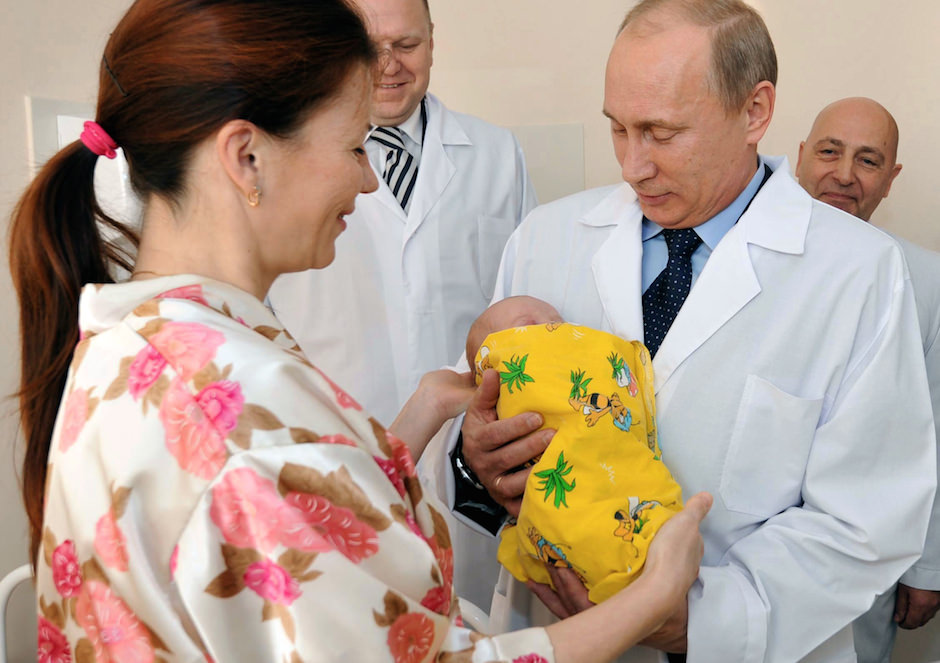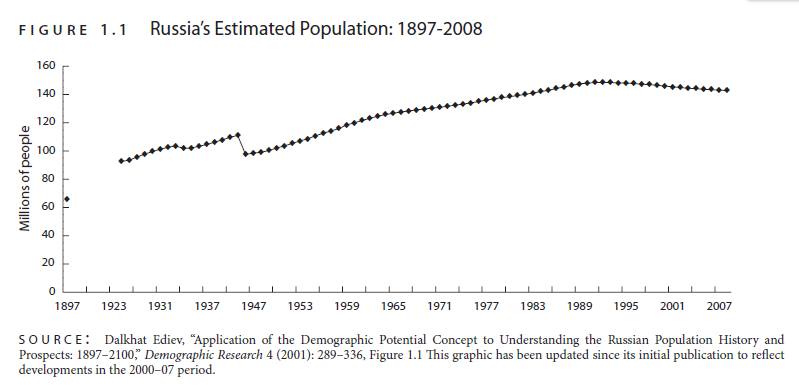Over at Forbes, Mark Adomanis claims to have found eight errors in my piece on Michelle Parsons’ and Nicholas Eberstadt’s books on Russian demographics. To prove his points, he gets extremely selective with dates data—for example, he sets out to prove that my thesis (really, Eberstadt’s thesis) that Russia’s mortality rate fell after 1989 and still has not recovered, but he starts his graph in 1991—because if he started it in 1989, it would be plain that my assertion is true. I can go on and detail all the cherry-picking and misinterpretations in Adomanis’s piece, but the careful reader can easily do that herself. So I’ll concentrate on the substance of his criticism.
Adomanis claims that President Vladimir Putin’s policies have allowed Russia to recover from its demographic crisis. In essence, he is taking issue with a single phrase in my article: “In this study, published in 2010, Eberstadt accurately predicts that in the coming years the depopulation trend may be moderated but argues that it will not be reversed.” The graph below, which Eberstadt uses in his study, ends in 2008; it shows that the depopulation trend had lasted nearly two decades by that point. The question is, has it been reversed in the last five years?
Rosstat, the Russian statistics authority, does not make it easy to answer, because in 2011 it went back and revised the figures for 2004-2009 based on the 2010 census—as the Rosstat website notes. What it does not note is that the 2010 census has been widely discredited: the refusal-to-participate rate exceeded 20 percent; in addition, as several Russian journalists documented, regional authorities inflated their figures in order to demonstrate their success in fighting—you guessed it—depopulation. By this time, Putin’s focus on the demographic crisis was well-articulated, and every regional bureaucrat wanted to report good figures, much as they do with elections.
But even if we use the Rosstat figures, they will show nothing like the decisive and sustained reversal of the depopulation trend that Adomanis claims has occurred. Here are the annual population figures according to Rosstat, starting in 2007 and ending in 2014:
142.8//142.8//142.7//142.8//142.9//143.0//143.3//143.7
The most favorable way to read these would be to say that there has been a leveling of the trend, but not a reversal—just as Eberstadt predicted. If, however, we take into account the policy of aggressively handing out resident Russian passports to ethnic Russians in border areas, which has been in effect during this period, then even the leveling is called into question. And the 2014 figure should include more than 2 million people from annexed Crimea; the fact that it doesn’t means that this is simply a projected figure thrown up at the very beginning of the year (before the March annexation) that has nothing to do with actual data.
Finally, we know that even this unconvincing moderation in the depopulation trend cannot hold, for one simple reason: the Russian demographic picture still reflects the aftereffects of WWII. Very few babies were born during and right after the war, and even fewer survived. So profound is the effect of this “demographic dip” that it has been felt strongly in each subsequent generation: Russian schools emptied out in the mid-1970s, when the children of the tiny war generation were entering first grade, and again and again at roughly twenty-five-year intervals. The grandchildren of the war generation are about to start having children in Russia, and this means, inevitably, another dip in the birth rate.
The Russian media love Adomanis: his Forbes blog entries frequently go up on RT, the state propaganda network. He is not the only Westerner who has recently been hailing Russia’s successes in confronting its demographic woes. I love the irony: if you listen to Putin’s useful idiot, you might think there is no demographic crisis in Russia. Which would be a problem, since so many of Putin’s most important policies are ostensibly aimed at confronting the demographic crisis.




